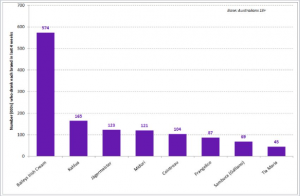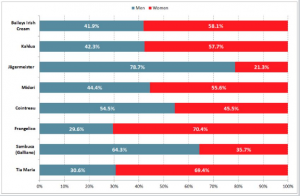This week Down Under
Study: Obese fathers pass on metabolic health to next two generations

With more than 14m Australians now overweight or obese, researchers are using their study’s findings to warn of the harmful legacy that parental obesity can have on future generations.
The scientists at the Victor Chang and Garvan institutes discovered that obese male mice put their offspring and future generations at significant risk of developing metabolic disease—long before these are even born.
The lead author on the study, Catherine Suter, says the discovery could have immediate ramifications for public health.
“A baby’s health has long been considered the mother’s responsibility as soon as she falls pregnant. But little attention has been paid to how a father’s health might impact his unborn child,” she said.
“Now, we’ve found powerful evidence, in a mouse model, that dad’s nutrition and metabolic health can influence his sons, and even his grandsons.”
The researchers analysed the effect of paternal obesity across three generations. At first, the offspring appeared to be in good metabolic health, but after consuming a high-fat, high-sugar junk food diet, all the male offspring reacted dramatically, and within just a few weeks they developed fatty liver disease and pre-diabetic symptoms. These included elevated glucose and insulin in the bloodstream, Associate Professor Suter said.
Moreover, the researchers found unexpectedly that the next generation of obese mice were also predisposed to metabolic disorders, just as their fathers were.
Importantly, this predisposition was transmitted to the grandsons even if their fathers ate well and were metabolically well at the time of conception.
“We were shocked when we saw the results, which were absolutely black and white. The grandchildren are at significant risk of getting very sick if they eat a ‘junk food diet’ – even when their father eats well and is healthy,” said Associate Professor Suter.
“The effects of the diet on offspring are dramatic, even when they eat poorly for just for a short time, all because their grandfather was obese.”
Mark Febbraio, also involved in the research, said the study should persuade men to reflect on their diet and make lifestyle changes. Those with an overweight or obese father or grandfather should be particularly careful, he warned.
“You can’t treat your body like a rental car, otherwise you run the risk of propagating this for generations. And, as a father-to-be, it’s worth considering whether your own health could impact on your children, and their children in turn,” Professor Febbraio said.
The researchers did reveal positive news, though, having observed that in the great-grandsons, the metabolic health would improve significantly.
By the third generation, the exaggerated response to a junk food diet was all but absent, showing that it is possible to break that cycle of metabolic disease.
“It’s crucial to note that this predisposition isn’t genetic. Instead, it’s acquired. That means the damage can be undone and is ultimately reversible,” said Associate Professor Suter.
It is still not entirely clear how this multigenerational programming is happening, but there appear to be clues within the sperm of the mice.
“We are now working to understand how changes in RNA molecules in the sperm could transmit the metabolic effects from generation to generation,” said Professor Febbraio added.
Source:
Accepted for publication in Molecular Metabolism
“Male-lineage transmission of an acquired metabolic phenotype induced by grand-paternal obesity”
Authors: Catherine Suter et al
More stories from Down Under…
Senior official: Australia needs preventative-curative health approach
Australian governments must wean patients off expensive hospital treatment by investing more heavily in preventative medicine and risk management, according to a senior health official, at a time when lifestyle diseases are putting a serious strain on health budgets.
Mark Cormack, deputy secretary of the federal Department of Health, said that a dramatic increase in conditions such as obesity and diabetes among Australian are now “well and truly outstripping” other serious diseases.
The government’s current emphasis on treatment over prevention means that the Treasury must pay for this imbalance unless other segments of the health industry play a role in mitigating the financial burden of healthcare spending that is constantly rising above inflation, he cautioned.
“A strong balance between preventive and curative care is essential to keep our economy strong and growing,” Cormack told the Australian’s Beyond the Boardroom forum in Sydney.
Cormack’s comments come shortly after the return of Malcolm Turnbull’s conservative Liberal government following a snap election. Ahead of the poll, the opposition Labor party announced a raft of cuts including a move to stop taxpayer-funded private health insurance rebates for natural therapies if it came to power.
The subsidy covers a wide range of natural therapies including complementary medicines, which have been shown to save the Australian economy A$10 for every A$1 invested in preventative health, according to CMA, the natural health industry lobby group.
The Liberals, however, have been working to gradually reduce the level of red tape required for the registration of complementary medicines in one of the world’s strictest regulatory environments.
Sussan Ley, reappointed as federal health minister, is expected to continue the government’s commitment to a “first-class health system”, and pursue the findings of an expert review of the medical regulatory system, which are wholeheartedly supported by CMA.
“The focus of the government on cutting regulatory red tape throughout the last parliamentary term was welcomed by the complementary medicines industry,” said Carl Gibson, CMA’s chief executive.
“Early adoption of the expert panel’s recommendations will ensure that Australia has an appropriate, current and exceptional regulatory system that promotes health and wellbeing, and supports and grows our industry.”
Canny brands should use strategic smarts to topple top tipple
When it comes to Australia’s overall liqueur consumption, one brand towers over all the others: Baileys Irish Cream, which is more than three times more popular than second-placed Kahlúa, and has nearly the same number of drinkers as the seven other most popular liqueurs combined.
Liqueurs may not be as widely consumed as beer, wine or spirits, but they are an important category within the alcoholic beverages market, according to Roy Morgan Research, which found that 1.5m Australian adults— 8% of the population—drink at least one liqueur in any given month, with different consumer groups being more likely than others to opt for a particular brand.
In the last year, 574,000 Australians have enjoyed at least one Baileys, compared to the 165,000 who have drunk Kahlúa. Jägermeister, Midori and Cointreau follow in third, fourth and fifth places, respectively.
Women who drink liqueur consume an average of five glasses in an average month, just ahead of male liqueur drinkers, who drink four glasses over the same period.
Perhaps more importantly for liqueur brands, just over three-quarters of Australia’s liqueur-tipplers prefer just the one brand, suggesting that they are generally loyal to their favourite, albeit with one key exception: the 18-24 year-old age bracket, nearly 35% of which opt for two or more brands in an average month.
Liqueurs do not account for a huge slice of the overall alcohol market, and for every 100 glasses of liquor consumed by Australian adults each month, only two are liqueur.
“But they are still an important category, with the potential for growth if brands are strategic about how they market themselves,” said Norman Morris or Roy Morgan Research.
By using strategic messaging to target the 18-24 demographic, who possibly haven’t yet been drinking long enough to have settled on a preferred tipple, “savvy brands could well persuade this group to stick with them,” Morris said.
“Also noteworthy is the fact that both the 18-24 and 25-34 year-old age groups are much likelier than the average Australian adult to drink cocktails in any given four weeks—a niche area within the liqueur category that could represent a golden opportunity for many brands, assuming they can anticipate the trends driving this ever-changing market.”













